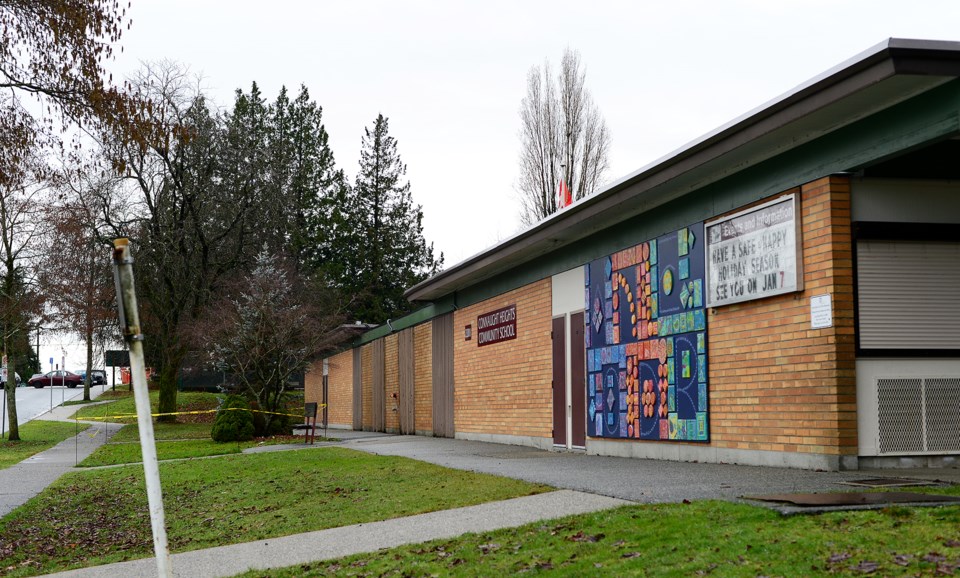Could New West schools benefit from a little bit of greening through additional tree plantings?
One of the items on the agenda for a June 3 joint meeting between the New Westminster board of education and New Westminster city council related to the city’s tree-planting program and the greening of schools.
“We are excited by your ambitious tree-planting goals,” trustee Maya Russell, chair of the school board, told city officials. “I thought trustees would be interested in hearing about that.”
Dean Gibson, the city’s director of parks and recreation, provided an overview of the city’s urban forest management strategy. The strategy, approved in 2017, aims to increase the tree canopy coverage from 18 per cent (across the city as a whole) up to 27 per cent by 2030.
To accomplish that goal, Gibson said the city determined about 12,000 new trees would need to be planted – with 8,500 on public lands and 3,300 on private lands. He said those numbers were based on the capacity of lands in New West to be able to accommodate trees in a way that they can grow and then thrive.
Gibson said the city tries to educate community members and raise awareness about the benefits and importance of the urban forests in New West in terms of general quality of life.
“And more recently, helping the city position itself to be more resilient in the face of climate change, in addition to just simply helping to head off climate change in the first place,” he said.
Russell questioned if school sites could play a role in any of the city’s tree-planting initiatives.
“Some of our school sites have really beautiful mature trees and are quite lush, but others are a bit sparse,” she said. “And same as you, we have the same concerns around rising heat and … helping them manage temperature for school sites.”
Russell said district staff have been “a little nervous” about suggestions from the board to add trees because of concerns the district may later need the site where trees have been planted for school construction or expansion.
“If there’s any area for cooperation there, we'd be very happy to discuss it,” she said.
Tree challenges
Gibson said sites selected by the city for tree plantings may not be entirely aligned with what the school district is able to support given the “intensification” of school sites. He noted that another challenge is that trees need a certain amount of soil volume and space to survive – something that’s generally not present on school sties.
“We do observe at some of our sites, particularly where we have playgrounds immediately adjacent to school properties, there’s a lot of pressure placed on the grounds themselves,” he said.
Trees planted in areas with “lower intensification” tend to survive and thrive, Gibson explained.
“When trees are planted and want to stand a fighting chance and being able to survive, they do need a level of maintenance and care for a minimum of seven years,” he said. “That sometimes makes it a challenge for school districts with the rationalization of your operating funds and where you're choosing to invest your moneys.”
Gibson said the city plants trees on boulevards around school properties.
Although the city has intentionally structured its urban forest management program in such a way that the city’s goals are not dependent on parties like the school district, he said the city is “wide open” to having discussions with the school district about what can be done to provide more trees at schools.
Trustee Danielle Connelly noted that schools are community gathering spaces.
“On evenings, weekends, they're very well-utilized by the community,” she said. “So in terms of having cool spaces, they certainly are ideal for that.”
Connelly questioned the city about a “significant delay” for a project at one of the schools, which involved one tree. Given the “crisis in capacity” when it comes to New West schools, she said she’d like to understand how the city and school district can ensure those types of delays don’t occur in the future.
City staff attending the meeting did not have details about the tree in question. (The Record has contacted Connelly to get additional information.)
Jackie Teed, the city’s director of planning and development, suggested that item be referred to the city council and school board joint working group for discussion. She said staff could provide information about the issue so there could be a robust discussion on the topic.
“That was a really helpful, briefing; we appreciate that, and then also just understanding some of the constraints around the heavy usage of school sites so we can take that back,” Russell said. “And I think regardless, this is a shared goal.”




